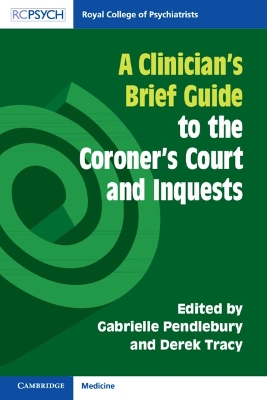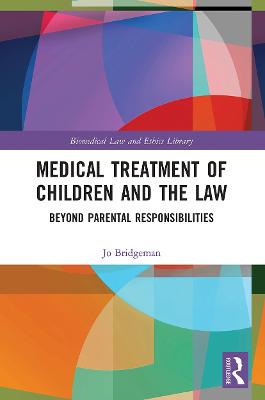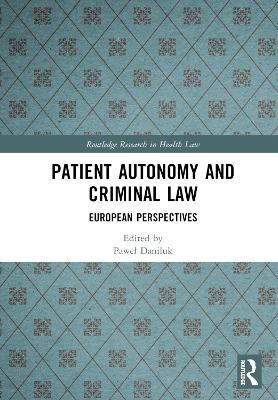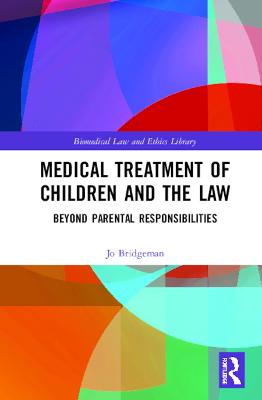Restrictive Practices in Health Care and Disability Settings
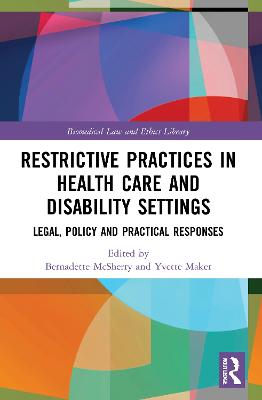 portes grátis
portes grátis
Restrictive Practices in Health Care and Disability Settings
Legal, Policy and Practical Responses
Maker, Yvette; McSherry, Bernadette
Taylor & Francis Ltd
08/2022
310
Mole
Inglês
9780367408725
15 a 20 dias
630
Descrição não disponível.
Part I: Background: Rationales and options for reform
1. Restrictive practices: options and opportunities
Bernadette McSherry and Yvette Maker
2. Ending restraint: an insider view
Cath Roper, Mary O'Hagan, Hamilton Kennedy and Helena Roennfeldt
Part II: Designing legislation and policy to support change
Introduction to Part II
3. Human rights and rapid tranquillisation
Peter Bartlett and Stephanie Sampson
4. The regulation of restrictive practices on people with intellectual impairment: the challenges and opportunities posed by a rights-based approach
Kim Chandler
5. Beyond restraint: gender-sensitive regulation of the control of women's behaviour in Australian mental health and disability services
Yvette Maker
6. Attempts to reduce the use of restrictive interventions in England between 2014 and 2019
Guy Cross
Part III: Implementing and monitoring reform
Introduction to Part III
7. Legal regulation and policy on the use of restraint and coercive measures in health care institutions in the Netherlands
Lisa Waddington
8. Queensland's new physical restraint framework: implementation and lessons since the commencement of the Mental Health Act 2016
John Allan and Amber Manwaring
9. Showing restraint: the uses and limitations of data in supporting restraint reduction
Grant Sara
10. The Court, the law and German psychiatry's slow progress towards human rights
Margret Osterfeld and Martin Zinkler
Part IV: Changing culture and practice
Introduction to Part IV
11. The intractable use of restraint, organisational culture and 'othering': lessons from the Oakden scandal
Bernadette McSherry
12. Being recovery-oriented and reducing the use of restrictive interventions in mental health care: the challenges in achieving transformation
Lisa Brophy, Justine Fletcher and Bridget Hamilton
13. Psychotropic use in Australian aged care homes: what can be done to ensure appropriate use?
Juanita Breen (previously Westbury)
14. Engaging doctors to reduce restraint: practice and pragmatics around restraint in clinical care
Nathan Gibson
Part V: Conclusions
15. Regulating restrictive practices: challenges and possibilities
Bernadette McSherry and Yvette Maker
1. Restrictive practices: options and opportunities
Bernadette McSherry and Yvette Maker
2. Ending restraint: an insider view
Cath Roper, Mary O'Hagan, Hamilton Kennedy and Helena Roennfeldt
Part II: Designing legislation and policy to support change
Introduction to Part II
3. Human rights and rapid tranquillisation
Peter Bartlett and Stephanie Sampson
4. The regulation of restrictive practices on people with intellectual impairment: the challenges and opportunities posed by a rights-based approach
Kim Chandler
5. Beyond restraint: gender-sensitive regulation of the control of women's behaviour in Australian mental health and disability services
Yvette Maker
6. Attempts to reduce the use of restrictive interventions in England between 2014 and 2019
Guy Cross
Part III: Implementing and monitoring reform
Introduction to Part III
7. Legal regulation and policy on the use of restraint and coercive measures in health care institutions in the Netherlands
Lisa Waddington
8. Queensland's new physical restraint framework: implementation and lessons since the commencement of the Mental Health Act 2016
John Allan and Amber Manwaring
9. Showing restraint: the uses and limitations of data in supporting restraint reduction
Grant Sara
10. The Court, the law and German psychiatry's slow progress towards human rights
Margret Osterfeld and Martin Zinkler
Part IV: Changing culture and practice
Introduction to Part IV
11. The intractable use of restraint, organisational culture and 'othering': lessons from the Oakden scandal
Bernadette McSherry
12. Being recovery-oriented and reducing the use of restrictive interventions in mental health care: the challenges in achieving transformation
Lisa Brophy, Justine Fletcher and Bridget Hamilton
13. Psychotropic use in Australian aged care homes: what can be done to ensure appropriate use?
Juanita Breen (previously Westbury)
14. Engaging doctors to reduce restraint: practice and pragmatics around restraint in clinical care
Nathan Gibson
Part V: Conclusions
15. Regulating restrictive practices: challenges and possibilities
Bernadette McSherry and Yvette Maker
Este título pertence ao(s) assunto(s) indicados(s). Para ver outros títulos clique no assunto desejado.
CRPD;Organisational culture;Australian Mental Health Services;Health care and disability settings;Aged Care Contexts;Mental health consumers;Rapid Tranquillisation;Aged care settings;State Mental Health Program Directors;Staff training;Chemical Restraint;Restraint Reduction;Prone Restraint;Restrictive Practices;Post-incident Reviews;Mechanical Restraint;Clinical Practice;Australian Mental Health;Restrictive Interventions;Mental Health Act Code;Involuntary Treatment;Positive Behaviour Support;Aged Care Facilities;Chief Psychiatrist;Physical Restraints;Common Law Justification;Mental Health Laws;Disability Services;Mental Health Act;Nice Guideline
Part I: Background: Rationales and options for reform
1. Restrictive practices: options and opportunities
Bernadette McSherry and Yvette Maker
2. Ending restraint: an insider view
Cath Roper, Mary O'Hagan, Hamilton Kennedy and Helena Roennfeldt
Part II: Designing legislation and policy to support change
Introduction to Part II
3. Human rights and rapid tranquillisation
Peter Bartlett and Stephanie Sampson
4. The regulation of restrictive practices on people with intellectual impairment: the challenges and opportunities posed by a rights-based approach
Kim Chandler
5. Beyond restraint: gender-sensitive regulation of the control of women's behaviour in Australian mental health and disability services
Yvette Maker
6. Attempts to reduce the use of restrictive interventions in England between 2014 and 2019
Guy Cross
Part III: Implementing and monitoring reform
Introduction to Part III
7. Legal regulation and policy on the use of restraint and coercive measures in health care institutions in the Netherlands
Lisa Waddington
8. Queensland's new physical restraint framework: implementation and lessons since the commencement of the Mental Health Act 2016
John Allan and Amber Manwaring
9. Showing restraint: the uses and limitations of data in supporting restraint reduction
Grant Sara
10. The Court, the law and German psychiatry's slow progress towards human rights
Margret Osterfeld and Martin Zinkler
Part IV: Changing culture and practice
Introduction to Part IV
11. The intractable use of restraint, organisational culture and 'othering': lessons from the Oakden scandal
Bernadette McSherry
12. Being recovery-oriented and reducing the use of restrictive interventions in mental health care: the challenges in achieving transformation
Lisa Brophy, Justine Fletcher and Bridget Hamilton
13. Psychotropic use in Australian aged care homes: what can be done to ensure appropriate use?
Juanita Breen (previously Westbury)
14. Engaging doctors to reduce restraint: practice and pragmatics around restraint in clinical care
Nathan Gibson
Part V: Conclusions
15. Regulating restrictive practices: challenges and possibilities
Bernadette McSherry and Yvette Maker
1. Restrictive practices: options and opportunities
Bernadette McSherry and Yvette Maker
2. Ending restraint: an insider view
Cath Roper, Mary O'Hagan, Hamilton Kennedy and Helena Roennfeldt
Part II: Designing legislation and policy to support change
Introduction to Part II
3. Human rights and rapid tranquillisation
Peter Bartlett and Stephanie Sampson
4. The regulation of restrictive practices on people with intellectual impairment: the challenges and opportunities posed by a rights-based approach
Kim Chandler
5. Beyond restraint: gender-sensitive regulation of the control of women's behaviour in Australian mental health and disability services
Yvette Maker
6. Attempts to reduce the use of restrictive interventions in England between 2014 and 2019
Guy Cross
Part III: Implementing and monitoring reform
Introduction to Part III
7. Legal regulation and policy on the use of restraint and coercive measures in health care institutions in the Netherlands
Lisa Waddington
8. Queensland's new physical restraint framework: implementation and lessons since the commencement of the Mental Health Act 2016
John Allan and Amber Manwaring
9. Showing restraint: the uses and limitations of data in supporting restraint reduction
Grant Sara
10. The Court, the law and German psychiatry's slow progress towards human rights
Margret Osterfeld and Martin Zinkler
Part IV: Changing culture and practice
Introduction to Part IV
11. The intractable use of restraint, organisational culture and 'othering': lessons from the Oakden scandal
Bernadette McSherry
12. Being recovery-oriented and reducing the use of restrictive interventions in mental health care: the challenges in achieving transformation
Lisa Brophy, Justine Fletcher and Bridget Hamilton
13. Psychotropic use in Australian aged care homes: what can be done to ensure appropriate use?
Juanita Breen (previously Westbury)
14. Engaging doctors to reduce restraint: practice and pragmatics around restraint in clinical care
Nathan Gibson
Part V: Conclusions
15. Regulating restrictive practices: challenges and possibilities
Bernadette McSherry and Yvette Maker
Este título pertence ao(s) assunto(s) indicados(s). Para ver outros títulos clique no assunto desejado.
CRPD;Organisational culture;Australian Mental Health Services;Health care and disability settings;Aged Care Contexts;Mental health consumers;Rapid Tranquillisation;Aged care settings;State Mental Health Program Directors;Staff training;Chemical Restraint;Restraint Reduction;Prone Restraint;Restrictive Practices;Post-incident Reviews;Mechanical Restraint;Clinical Practice;Australian Mental Health;Restrictive Interventions;Mental Health Act Code;Involuntary Treatment;Positive Behaviour Support;Aged Care Facilities;Chief Psychiatrist;Physical Restraints;Common Law Justification;Mental Health Laws;Disability Services;Mental Health Act;Nice Guideline

